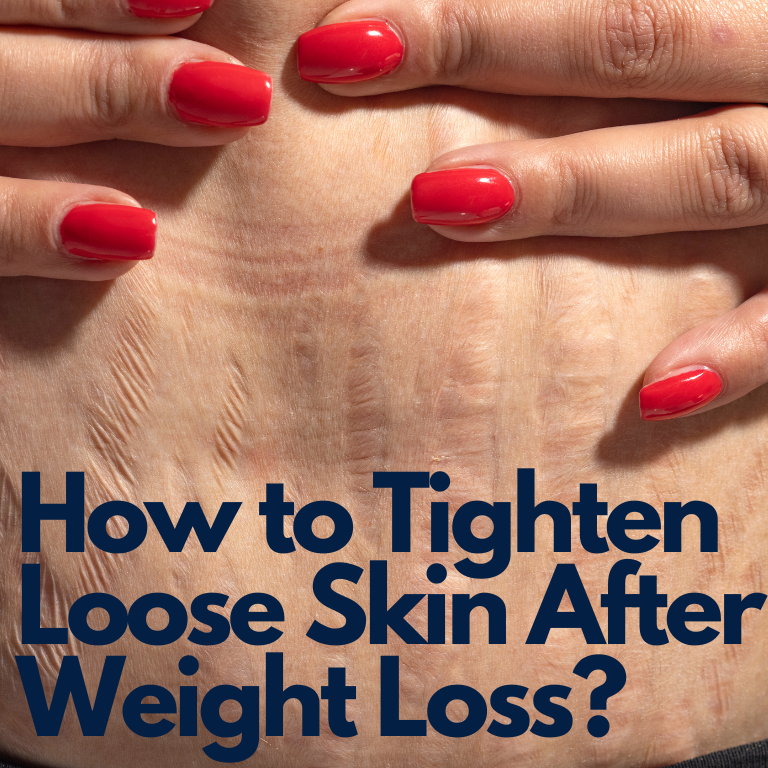
Table of Contents
Introduction
Loose skin develops when your skin is stretched beyond its usual limits and doesn’t regain its original tightness. It’s similar to stretching a rubber band too far, where it loses its elasticity. This stretching affects the collagen and elastin fibers, which are essential for skin elasticity and structure. In this article, I’ll provide guidance on how to tighten loose skin after weight loss, sharing natural techniques to restore firmness without resorting to surgery or invasive procedures.
While some may wonder if increasing collagen consumption could alleviate the problem, it’s typically not a lack of collagen intake but rather factors such as aging, significant weight loss, sun exposure, pregnancy, smoking, diabetes, or high-stress levels that contribute to the breakdown of collagen fibers, resulting in loose skin.
Understanding Loose Skin
Before we explore the steps on how to tighten loose skin after weight loss, it is crucial to grasp that loose skin originates from the skin being stretched beyond its limits, leading to a decline in elasticity and structural integrity. Collagen and elastin fibers, vital components for skin elasticity, become compromised in this process. Despite common misconceptions, simply increasing collagen intake isn’t the solution. Instead, factors like aging, weight loss, sun exposure, pregnancy, smoking, diabetes, or stress play significant roles in the development of loose skin by causing the degradation of collagen fibers.
Understanding these factors is crucial in addressing loose skin effectively and considering appropriate interventions. So, let’s explore all the different aspects and activities you can start engaging in right away.
Hormonal Influence on Loose Skin
Let’s begin with hormones. There are two distinct groups of hormones – those that promote the synthesis of collagen and elastin, and those that facilitate their breakdown within the skin.
Cortisol is the primary hormone responsible for this breakdown process—it’s a catabolic hormone, meaning it breaks down tissue, including the proteins collagen and elastin. Stress triggers the release of cortisol, exacerbating this effect.
Conversely, there are hormones with anabolic properties, such as growth hormones. Growth hormones not only play a role in anti-aging and fat burning but also serve a specific function in promoting the growth of proteins like muscle, collagen, and connective tissue.
Maximizing Growth Hormone Levels
There are three primary methods to boost growth hormone levels: High-intensity exercise, dietary considerations, and adequate sleep.
High-intensity exercise, such as sprinting, plyometrics, or spin biking, stimulates growth hormone production, particularly when performed in short, intense intervals to avoid overtraining. This approach, known as high-intensity interval training (HIIT), involves brief bursts of high-intensity activity followed by ample rest periods, typically lasting 2 to 5 days to ensure proper recovery and minimize inflammation.
Additionally, maintaining a low-carb ketogenic diet helps to prevent the inhibition of growth hormone by glucose.
Moreover, prioritizing sufficient sleep is crucial for optimizing growth hormone levels and managing stress. Inadequate sleep can significantly hinder growth hormone production, highlighting the importance of addressing any sleep-related issues. While comprehensive guidance on improving sleep quality may require a separate discussion, it’s essential to recognize its significance in maximizing growth hormone benefits and overall well-being.
Insulin’s Anabolic Potential
This next concept is quite intriguing. Another hormone with anabolic properties, meaning it aids in building proteins, is insulin. Insulin plays a crucial role in stimulating the production of new elastin, the connective tissue responsible for skin elasticity akin to a rubber band. This might seem counterintuitive, especially considering the association with diabetes. In type 2 diabetes, individuals experience insulin resistance, where the body produces insulin, but cells fail to respond effectively, leading to elevated insulin levels in the bloodstream. However, insulin deficiency can still occur within certain tissues despite this abundance elsewhere in the body.
Addressing insulin resistance is key to optimizing insulin levels, and this can be achieved through methods like the ketogenic diet, intermittent fasting, and regular exercise. Additionally, insulin resistance not only impedes the delivery of fuel and nutrients but also hinders the absorption of essential amino acids necessary for collagen and elastin synthesis. Therefore, a comprehensive approach should involve correcting insulin resistance to facilitate the absorption of amino acids, thereby preventing muscle loss and promoting skin health.
Vitamin A and Fat-Soluble Nutrients
Now, let’s explore collagen and elastin and their associated factors—nutrients crucial for their development. Among these, vitamin A stands out as the most important. It’s worth noting that when we refer to vitamin A, we’re focusing on its active form, retinol, rather than the precursor beta-carotene found in plants. Retinol is exclusively sourced from animal products like egg yolks, cod liver oil, fatty fish, and butter, whereas beta carotene, found in vegetables like spinach, needs to convert into retinol within the body, a process not always efficient for everyone. Despite both being labeled as vitamin A, they are distinct molecules with different functions. Vitamin A, particularly retinol, plays a pivotal role in collagen synthesis.
Additionally, all fat-soluble vitamins are vital for skin health, highlighting the importance of including healthy fats in your diet. Opting for a low-fat diet can be detrimental to skin health. For instance, some diets, such as the “ideal protein” diet, may be low in both carbohydrates and fats. While ketogenic diets typically prioritize low carbs but higher fat intake, it’s essential to ensure an adequate amount of fat for optimal skin health.
Prioritizing Bioavailable Heme Iron
Another crucial factor essential for collagen and elastin is iron, specifically heme iron. This form of iron, found in red meat and shellfish, is more readily absorbed by the body compared to non-heme iron found in vegetables. It’s important to prioritize the intake of bioavailable iron to support the synthesis of collagen and elastin effectively.
These two above-mentioned essential components illuminate the dietary requirements necessary for collagen and elastin production. Opting for animal products that are not lean but rather contain a higher fat content ensures adequate intake of both retinol and heme iron. However, individuals following a plant-based vegan diet must carefully plan to obtain these essential nutrients. While it’s feasible to meet these requirements on a plant-based diet, it can be more challenging. Unfortunately, many individuals on a plant-based diet end up consuming excessive grains and omega-6 fatty acids, leading to increased inflammation and exacerbating the situation.
Vitamin C for Skin Health
Alright, the final essential nutrient is vitamin C, and I’d like to highlight something about it. Vitamin C is crucial for collagen production, but many people consume the synthetic form rather than the natural version found in whole foods. To ensure optimal intake, it’s best to focus on food-based sources of vitamin C or foods naturally high in this nutrient. Sauerkraut is an excellent option as it contains more vitamin C than any other food, providing about ten times the recommended daily amount. Additionally, vitamin C can be obtained from peppers, berries, and other similar foods.
Skin Health and Massage Therapy
Massage therapy can play a significant role in promoting skin health by enhancing circulation, stimulating lymphatic drainage, and improving overall skin tone and texture. When performed correctly, massage techniques can help increase blood flow to the skin, delivering essential nutrients and oxygen while removing toxins and metabolic waste products. This improved circulation can contribute to a healthier complexion, reducing the appearance of dullness and promoting a natural glow.
Additionally, massage can help relax facial muscles, reducing tension and minimizing the formation of wrinkles and fine lines over time.
Exercise and Skin Health
Next, let’s discuss the importance of exercise. While exercise is vital, it’s crucial not to overtrain. Through exercise, you stimulate neovascularization, which involves the formation of new blood vessels, enhancing nutrient delivery and circulation to the skin. This process helps fill in the gaps caused by skin stretching, leading to a smoother appearance with less loose skin. High-intensity interval training, in particular, can stimulate growth hormone production, further aiding in skin tightening.
Prolonged Fasting for Skin Renewal
Another beneficial practice is prolonged fasting. This method induces an epigenetic effect on the skin by promoting autophagy, where the body recycles old and damaged proteins. Glycation, a process occurring in conditions like insulin resistance and diabetes, results in the binding of sugar molecules to proteins, causing damage. Prolonged fasting can help mitigate this damage by allowing the body to cleanse and rejuvenate tissues, including collagen and elastin in the skin. This process can also have positive effects on other areas affected by glycation, such as the eyes, kidneys, arteries, brain, and nerves.
Hormetic Stress for Skin Enhancement
The next concept builds upon the previous two points, involving the creation of a hormetic effect. This effect involves introducing mild stress to the body to prompt adaptation and strength-building. Prolonged fasting and exercise are two examples of activities that induce a hormetic effect. Additionally, exposure to heat and cold can also achieve this. Alternating between ice-cold water and warm or hot water on the face, for instance, can stimulate skin cells and promote tissue toning. While this method is particularly effective for addressing loose skin on the face, similar techniques can be applied to other areas of the body as well to achieve similar results.
Sun Exposure and Skin Health
Now, I’d like to touch on the topic of sun exposure for a moment. While excessive sun exposure can be harmful to your skin, it’s important to note that moderate sun exposure, before reaching the point of sunburn, can be beneficial. This moderate exposure induces a hormetic effect, stimulating healthy skin. However, the impact of sun exposure also depends on factors such as your skin’s melanin levels and complexion. Those with fair skin are more prone to sunburn and need to exercise caution when spending time in the sun.
Conclusion
In conclusion, managing loose skin involves a multifaceted approach that addresses various factors contributing to its development. From understanding the hormonal influences to optimizing growth hormone levels and ensuring adequate intake of essential nutrients like vitamin A, heme iron, and vitamin C, there are numerous natural strategies available. Incorporating practices such as massage therapy, exercise, prolonged fasting, and hormetic stress induction can further enhance skin health by promoting circulation, rejuvenating tissues, and stimulating skin tightening. Additionally, adopting sun exposure in moderation and considering individual skin characteristics are crucial for maintaining skin health. By integrating these techniques and lifestyle changes, individuals can effectively manage loose skin and restore firmness without resorting to invasive procedures.
Frequently Asked Questions (FAQs)
What causes loose skin?
Loose skin typically results from factors like aging, significant weight loss, sun exposure, pregnancy, smoking, diabetes, or high-stress levels, which lead to the breakdown of collagen and elastin fibers.
Can increasing collagen intake help with loose skin?
While collagen is essential for skin health, simply increasing collagen consumption is not usually the solution. Addressing underlying factors like hormonal imbalances and nutrient deficiencies is more effective.
How can hormones influence loose skin?
Hormones like cortisol and growth hormone play crucial roles in collagen and elastin synthesis and breakdown. Managing stress levels and optimizing hormone levels through lifestyle changes can help improve skin elasticity.
What dietary considerations are important for skin health?
Prioritizing nutrients like vitamin A, vitamin C, heme iron, and healthy fats supports collagen and elastin production. Consuming a balanced diet rich in these nutrients is essential for maintaining skin health.
What role does exercise play in skin health?
Exercise stimulates circulation and promotes the formation of new blood vessels, enhancing nutrient delivery to the skin. High-intensity interval training can further boost growth hormone levels, contributing to skin tightening.
How does prolonged fasting benefit skin renewal?
Prolonged fasting induces autophagy, a process where the body eliminates damaged proteins and rejuvenates tissues, including collagen and elastin in the skin. This promotes skin renewal and improves overall skin health.
Is moderate sun exposure beneficial for skin health?
Moderate sun exposure stimulates healthy skin by inducing a hormetic effect. However, it’s essential to avoid excessive exposure to prevent sunburn and other skin damage.
For general inquiries, feedback, or questions about our content – Contact Us
